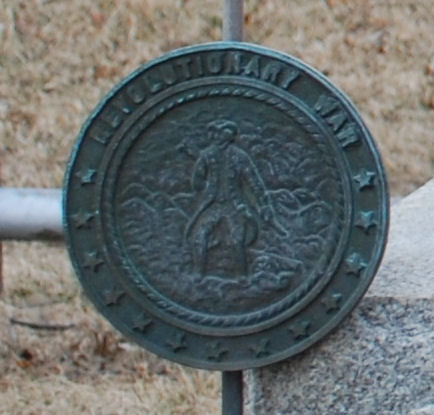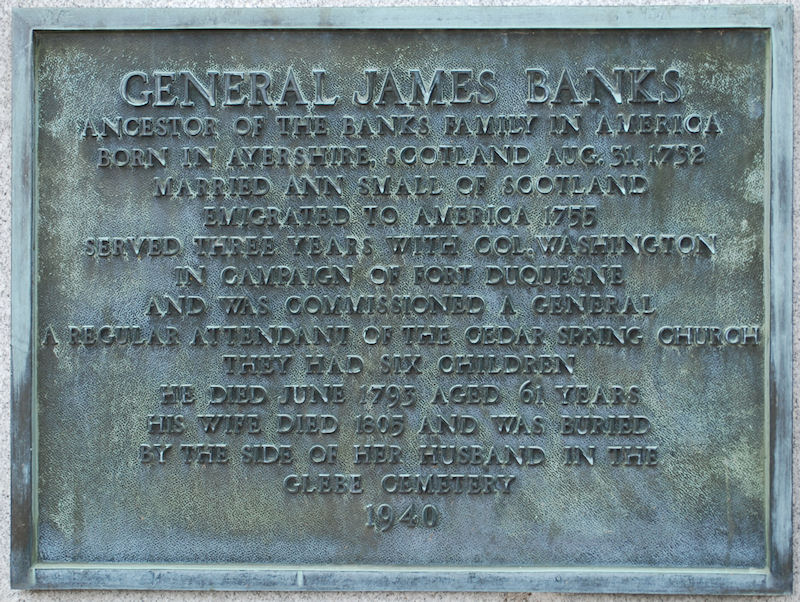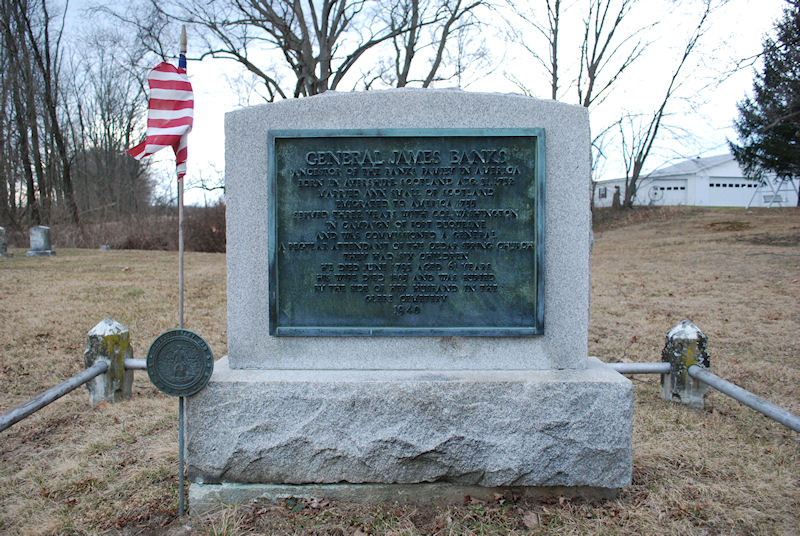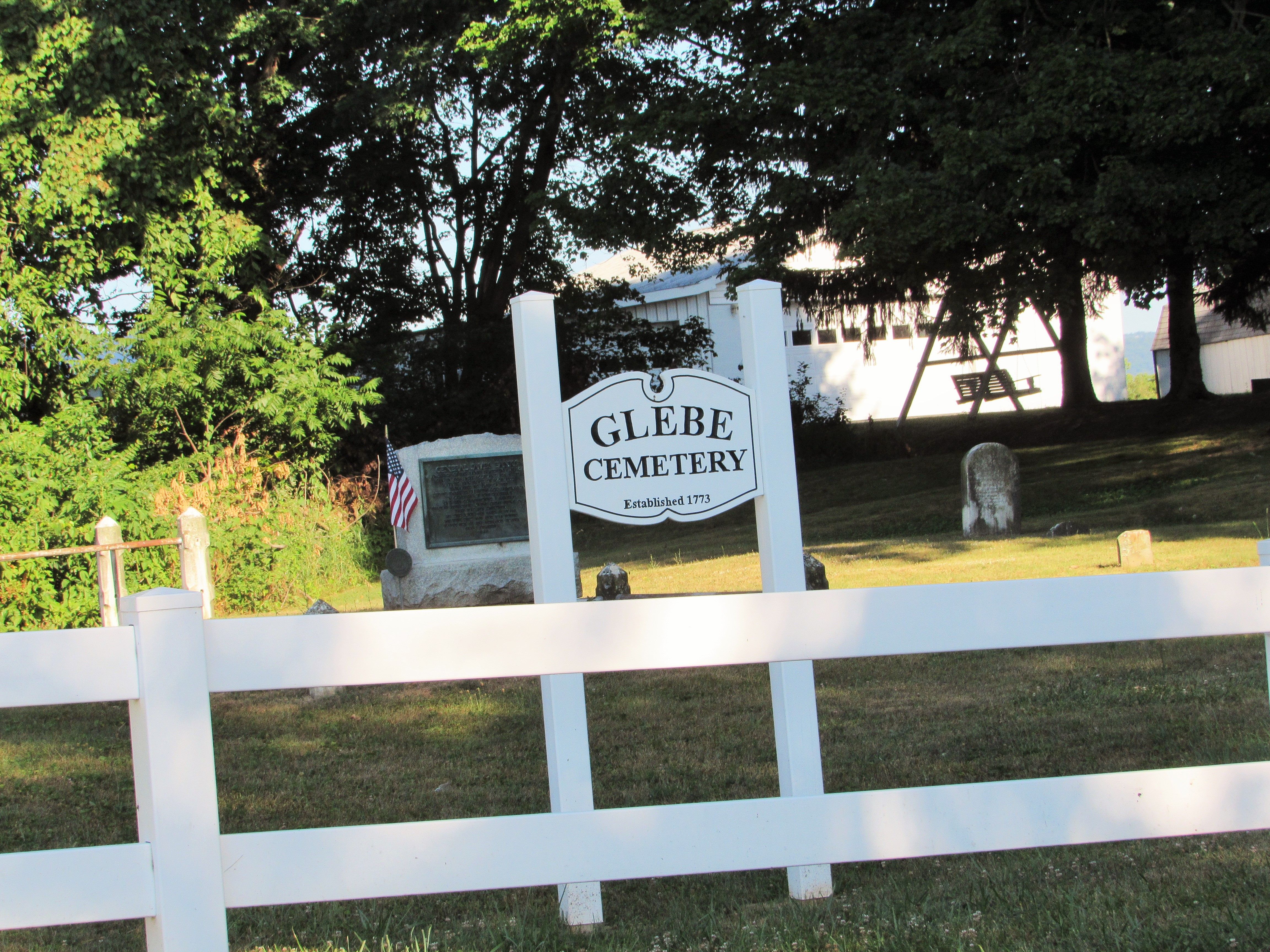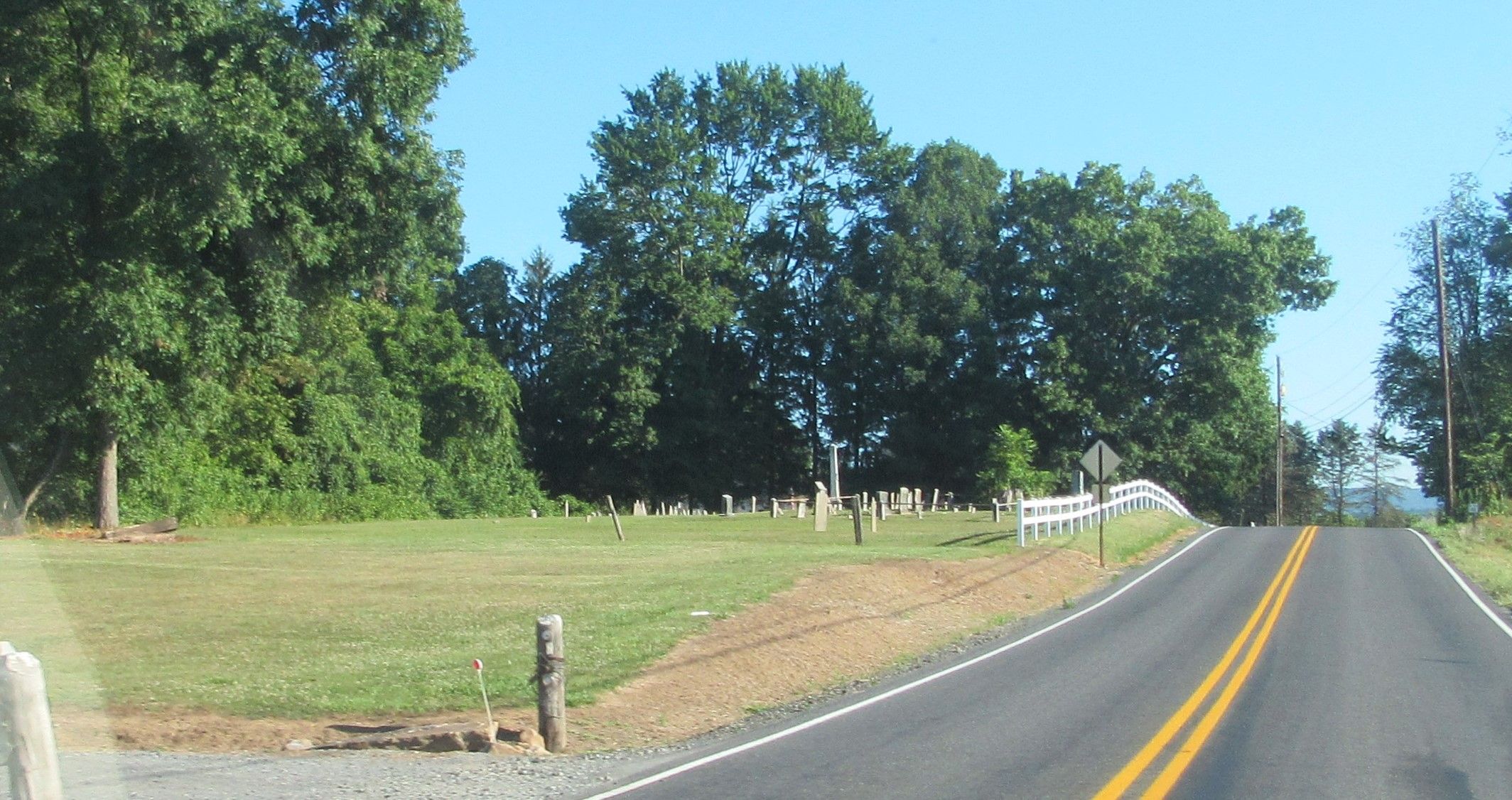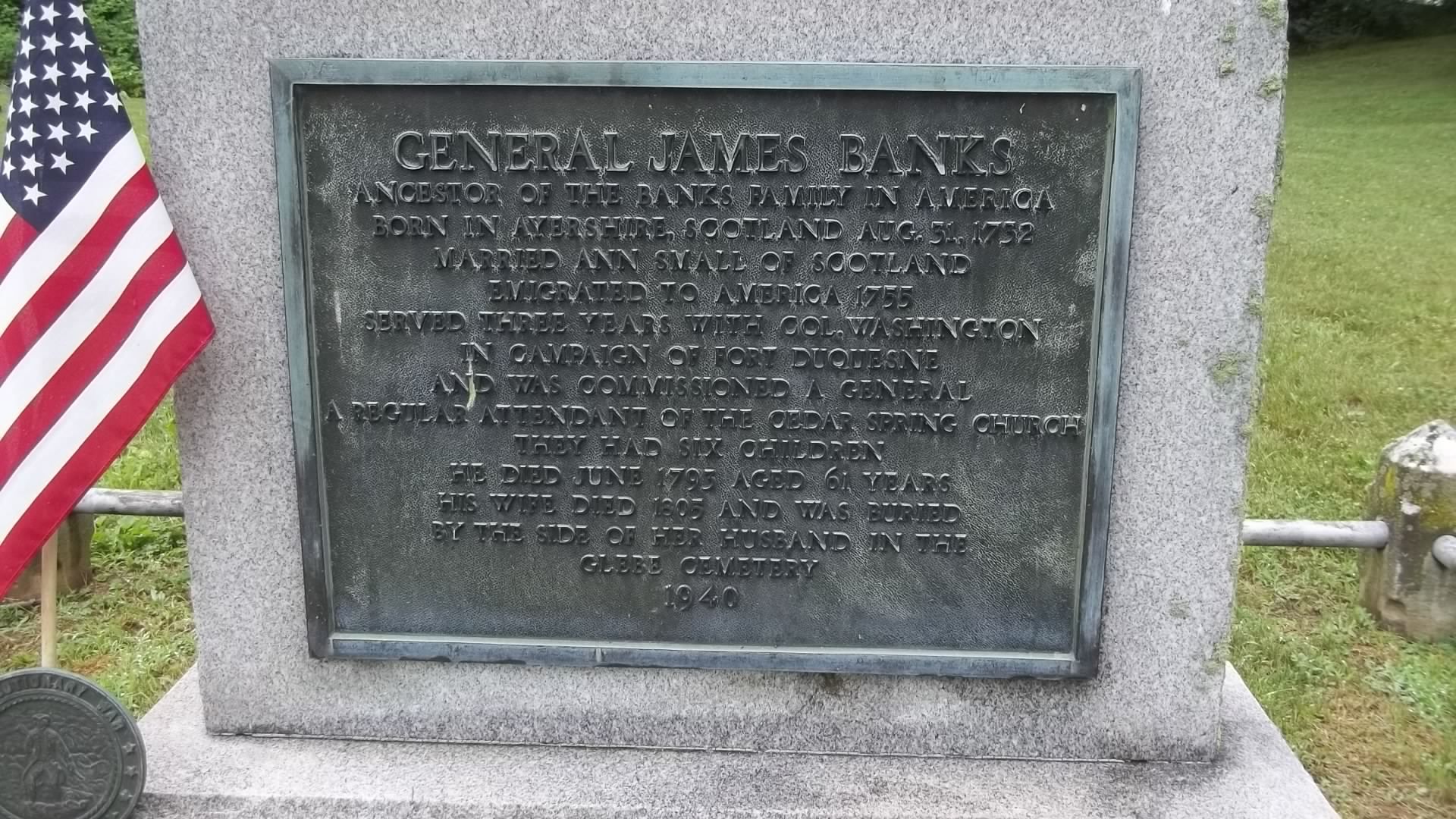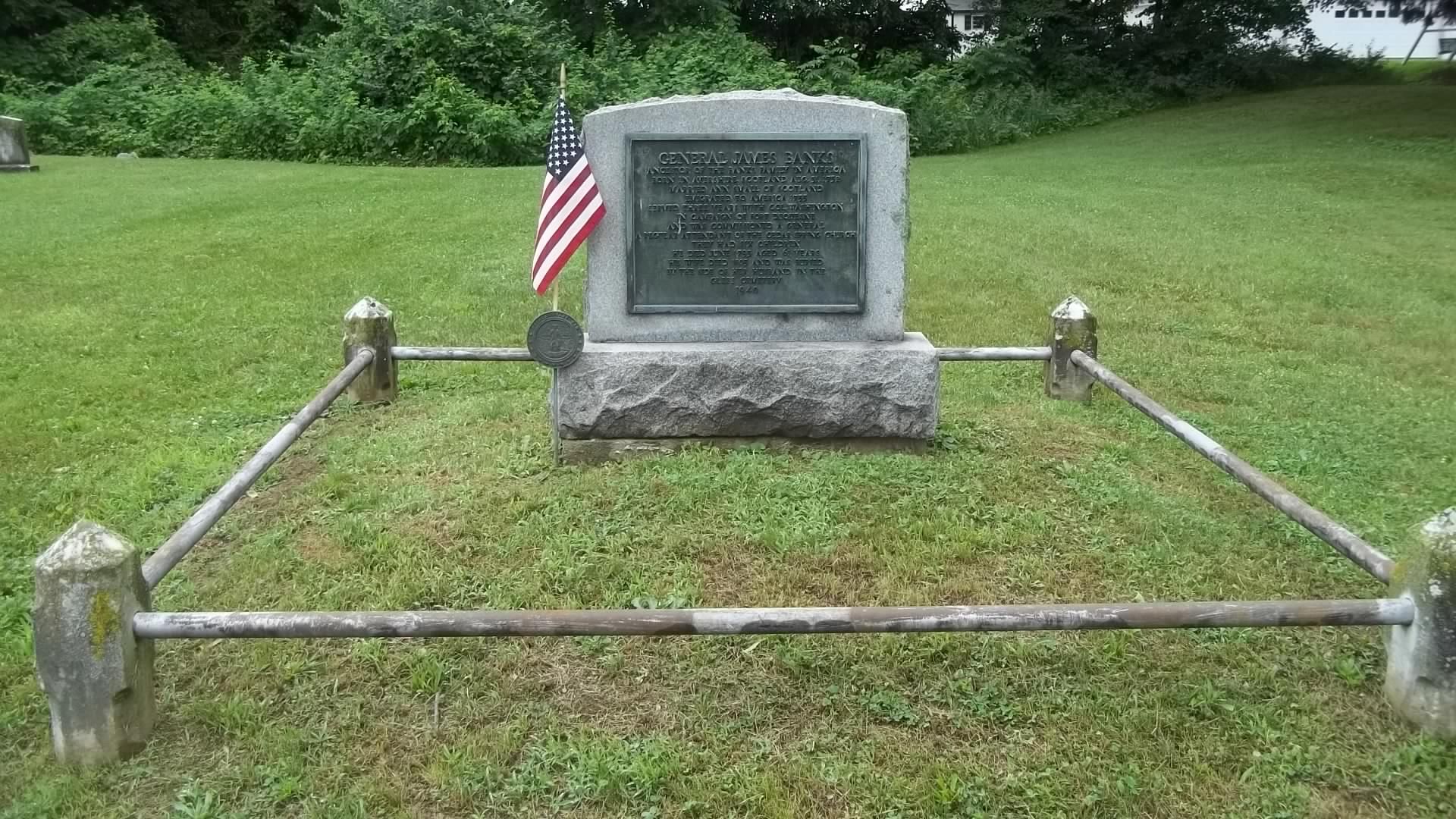The following extracts from Everts, Peck and Richards History (pp 824-825) describes James Banks' life:
James "was the ancestor of the Banks family in America. Whilst there is no reason to believe that he was brought up in luxury, he enjoyed the advantages of a fair education, and, according to the custom of the place and day, was carefully indoctrinated in the principles of religion, the hopes and habits of which were strictly adhered to in all his subsequent life.
"He spent some time in travel in England, where he witnessed something of the profligacy and intolerance of the reigning power, and acquired an intense dislike for monarchical institutions. Immediately upon his return from a second tour through England, he took, as the partner of his life, Miss Anna Small, a lady endowed with a vigorous constitution, personal beauty, intelligence and religion. The union was a happy one, and James Banks had a wife well qualified to share with him the adventures and trials which were to follow. Shortly after their marriage they began to meditate emigration to America. The chief hindrance to this step in Mrs. Banks' mind was the fear that in this then new and far-off country they would be deprived of the ordinances of religion, which she valued so highly at home.
"Two brothers of Mrs. Banks had emigrated to America a short time previously, a circumstance which may have had some influence in favorably disposing her toward the step they were about to take. Having collected together what little property they had, they sailed for America and landed at Christiana Bridge in the State of Delaware. From here they at once went to New London Cross-Roads, Chester County, Pa., where they made their first home in this country, in a house owned by Captain William Clinton, a brave and noble-hearted man, who treated them with the utmost generosity and respect--a kindness and courtesy of which they afterward made frequent and grateful mention.
"About this time the inhabitants of Western Pennsylvania and Virginia were much annoyed by frequent incursions of bands of Indians, who broke in upon the border settlements, butchered the people and burned their dwellings. It became necessary to do something for their protection. A small army was raised and Colonel Washington, then a rising young officer, was put in command. Captain Clinton raised a company of volunteers, in which James Banks enlisted and served two years, sharing in all the discouragements, toils and dangers of the campaigns of 1756-57 on the western frontiers of Pennsylvania and Virginia. After his return from this expedition, James Banks, in 1758, enlisted in the army of General Forbes, which marched against Fort DuQuesne."
He served with Captain John Singleton beginning on May 6, 1759. His name is on line 17 of a document which lists 55 recruits for the regiment. The list is endorsed "A Muster Roll of Capt Jno Singletons Compy of New Levies Pen Completed May 6th 1759 56 men officers Included." Jams. Banks' date of induction was Apr 28, his age listed as 28 (actually, he would have been 27 in four months), height five feet, six inches, born in Scotland, his trade was Jobber, and he had a reddish complexion. (Reel 585, RG 21)
"The term of his enlistment having expired, James Banks returned to his home in Chester County and resolved to settle down in the quiet pursuits of a farmer's life. With the money which he had saved from his meagre pay as a soldier he purchased a small tract of land in York County, Pa., about ten miles southeast of York, and eight miles from Wrightsville and two miles from Brogue Tavern. This was the first property owned by the family in America. He purchased another tract two miles south of the one on which he resided. This was known as 'the Mount Gilboa tract.'
"In 1772, in company with Joseph Bogle, he took a tour trough Cumberland County, which at that time embraced an immense tract in Central Pennsylvania. He purchased of William Sharon a tract of one hundred and seventy-two acres, for about seven hundred dollars, in Lost Creek Valley now embraced in the Heckman farm, six acres only being cleared, and no building on it except a little log hut. . . .
"Soon after making this purchase, James Banks sold his lands in York County, and removed, in 1773, with his family, to his new farm in Lost Creek Valley. The route taken was by way of Carlisle, thence to the Juniata, crossing it at Millerstown. Here they spent the night in the woods beside a huge fire of pine knots. The next day about noon, after a very tedious journey, they arrived at their little cabin in the wilderness. The day following their arrival being Sabbath, the family, worn out by their week's travel, rested; but James walked two miles to the Cedar Springs, where Rev. Mr. Kennedy preached to a few settlers. Whilst he was absent, a fire broke out in the woods, which for a time threatened to leave the newcomers entirely shelterless; but by their strenuous exertions the hut was saved. During the summer this humble habitation underwent some improvement. The clapboard roof was taken off and it was raised four rounds of logs higher, and covered with shingle roof. This was the second shingle-roof in the neighborhood, that of Major McAlister's being the first.
"As already stated, the tract in Lost Creek Valley upon which James Banks settled, in 1773, was for the most part heavily timbered. He, however, entered upon the improvement of his new farm with characteristic vigor. Each year he added as much as possible to the amount of cleared land, and it was not long until he found himself possessed of a property of considerable value. The low marshy parts had been converted into good grass-producing meadows, and the higher ground into fields yielding heavy crops of wheat and corn. Sixteen acres had been added to his original purchase.
"After a lapse of ten years' unabated labor on his farm James Banks began to realize that he was in the decline of life. The severe endurance of army experience, and the subsequent years of toil in clearing and cultivating his land, now began to tell upon his naturally vigorous physical frame. He accordingly handed the management of the farm over to his sons and spent the evening of his life in quietude. Retaining his mental vigor and being fond of books, he gave himself principally to reading. He had a large acquaintance with history, read many works on doctrinal and practical religion, and even acquainted himself with branches of science not at that time familiar to the generality of readers. The Bible, however, was the book of his daily and diligent study.
"He died in June, 1793, aged sixty-one years. His remains were interred in the place of burial at the 'Old Seeder Church,' two miles distant." This church is long gone. It was no longer used after 1799, when the congregation divided, part to form the church at McAllisterville, and part to form the church at Mifflintown. The cemetery still remains. It is located about 2.4 miles from Mifflintown, approximately .5 mile just off the Cedar Spring Road which begins at Mifflintown. The cemetery is variously known as the Glebe cemetery, Diven's cemetery and the Cedar Spring cemetery, and is maintained by the Juniata County Historical Society.
"In Scotland James and Ann Banks had both been members of the Presbyterian Church; but after coming to America, from some unknown cause, they joined the Seeders. The change may have been caused by the absence of any church of their earlier preference in the neighborhood in which they resided in York County.
"In stature James Banks was five feet nine inches high; he weighed about one hundred and sixty pounds, had red curly hair, fair complexion and blue, piercing eyes. He was a congenial companion, interesting and instructive in conversation, firm in his convictions and averse to controversy. He was a loyal citizen, and took a lively interest in public affairs. He was esteemed by all who knew him."
". . . James and Ann Banks had six children, -- Margaret, Jean, Ann, James, Andrew and John. . . Jane, in 1782, maried John Beatty, and they moved to Penn's Creek, where New Berlin now is. She died in 1801, leaving two sons and three daughters. John Beatty subsequently moved to Ohio, where his descendants are a wealthy and influential people. . ." (History of that part of the Susquehanna and Juniata Valleys, embraced in the Counties of Mifflin, Juniata, Perry, Union and Snyder, in the commonwealth of Pennsylvania. In Two Volumes. Vol. 1. Philadelphia: Everts, Peck and Richards, 1886, pp. 824-826)
In an article written for the Baltimore Sun on Jun 4, 1905 entitled "Maryland Heraldry, History of Distinguished Families and Personages: The Banks Lineage and Armes of Sturdy Scotch Stock," Emily Emerson Lantz stated:
"James, the eldest son, was born August 31, 1732 in Ayrshire, Scotland, came to America in the middle of the 18th century, having first married a Scotch lass, Ann Small. With her he came first to Virginia, and his first patriotic service to the land of his adoption was under Washington, whose forces he joined and fought for the protection of the frontier (now Pittsburgh) against the Indians and French. He was with Braddock when that gallant soldier was defeated, and later served three years with the Colonial Army with such distinction as to receive the rank of General.
"General Banks was among those, who coming to America (and then) from Virginia, followed the Susquehanna River toward the mountains of Pennsylvania in selecting a site for his future home. His military duties ended he purchased land at Peachbotton, territory disputed by Maryland and Pennsylvania, and died in 1793 in Juniata County, Pennsylvania, and is buried in the homestead burying ground on Cedar Spring farm of that county.
"He was a man of great learning, high-toned and honorable, exceedingly handsome and a devout Presbyterian. A taste for travel was early developed in him, and he spent much of his youth in England, and some writers have said that his wife, Ann Small, was an English girl, but careful research indicates this flower of womanhood, whose wedding journey was across the seas, was a bonny bit of sturdy Scotch heather, rather than an English rose."
Some members of the Daughters of the American Revolution (DAR) who claimed James Banks as their ancestor for membership, and their membership numbers, were: Annette Reid Joseph, 512709; her mother, Pansy Tibbets Reid, 441966; her sister, Lynn Reid Daniel, 479520; and her aunts, Lola Tibbets Beasley, 424595, and Ruby Tibbets Clem, 424596. Other member numbers included 60250 and 172458.
Their DAR memberships cited James Banks' service as follows:
"Served three years with Gen. Washington in the campaign of Fort Duquesne, and was commissioned a general. From a monument to 'General James Banks' near Mifflintown Pa. which was standing in 1941 - apparently erected in 1940." The full text of the monument which was erected near Mifflintown was:
"Ancestor of the Banks family in America. Born in Ayrshire, Scotland, Aug. 31, 1732. Married Ann Small of Scotland. Emigrated to America, 1755. Served three years with General Washington in the campaign of Fort Duquesne and was commissioned a general. A regular attendant of the Cedar Springs Church. They had six children. He died, June 1793, aged 61 years. His wife died, 1805, and was buried by the side of her husband in Glebe Cemetery. 1940"
However, the word "general" was crossed out on three applications, and his service with Gen. Washington was crossed out on two applications. In different handwriting (apparently by a DAR official) the words are added, "Patriot - rendered material aid." The DAR Patriot Index also lists James Banks as having no rank, and credited him only with "public service." This indicates that the DAR did not accept the documentation for James Banks' rank of general and his service with Washington.
The National Cyclopedia of American Biography, New York, 1910, page 482, in a biography of James Banks' great grandson James Banks Reynolds (1822-1882), it was recorded: "His grandfather married a daughter of James Banks, a sterling patriot who took part in the revolutionary war, and was one of the martyrs imprisoned in the notorious British ship in Wallabout Bay, where so many of the American prisoners lost their lives from the hardship and ill-treatment of the British. He was fortunate in effecting his escape." This story, like the one where he was promoted to general, has not been documented independently, and is perhaps restricted to family lore.
Members of the Sons of the Revolution who claimed James Banks as their patriot ancestor, and their membership numbers, were: Guy Nelson Henninger 060250, Wallace Guhl Quest 082818, Thomas Allen Quest 125105, John Douglas Quest 128209, and Larry Patrick Cornwell, 138085. The latter application records James Banks' service as "private, PA." References to James Banks' Revolutionary War service include the Pennsylvania Archives Fifth Series Vol V, 1906, pp 799, 805, and 814.
He was buried in the Glebe Cemetery, Mifflintown, Juniata County, Pennsylvania.
The children of James Banks and Anna Small were:
i Margaret, m. Andrew Moore in 1780
*ii Jean (Jane), b. m. 1760, in. John Beatty in 1782, d. 1801
iii Ann, b. 1755 (?), m. David Walker
iv James, b. 1765, m. Catherine Nelson, d. 1837
v Andrew, b. Jan 12, 1767, m. Elizabeth Lintner on Jan 14, 1790, d. Dec 28, 1855
vi John
∼James was a General in the French & Indian War and gave patriotic service to the American Revolution.
The following extracts from Everts, Peck and Richards History (pp 824-825) describes James Banks' life:
James "was the ancestor of the Banks family in America. Whilst there is no reason to believe that he was brought up in luxury, he enjoyed the advantages of a fair education, and, according to the custom of the place and day, was carefully indoctrinated in the principles of religion, the hopes and habits of which were strictly adhered to in all his subsequent life.
"He spent some time in travel in England, where he witnessed something of the profligacy and intolerance of the reigning power, and acquired an intense dislike for monarchical institutions. Immediately upon his return from a second tour through England, he took, as the partner of his life, Miss Anna Small, a lady endowed with a vigorous constitution, personal beauty, intelligence and religion. The union was a happy one, and James Banks had a wife well qualified to share with him the adventures and trials which were to follow. Shortly after their marriage they began to meditate emigration to America. The chief hindrance to this step in Mrs. Banks' mind was the fear that in this then new and far-off country they would be deprived of the ordinances of religion, which she valued so highly at home.
"Two brothers of Mrs. Banks had emigrated to America a short time previously, a circumstance which may have had some influence in favorably disposing her toward the step they were about to take. Having collected together what little property they had, they sailed for America and landed at Christiana Bridge in the State of Delaware. From here they at once went to New London Cross-Roads, Chester County, Pa., where they made their first home in this country, in a house owned by Captain William Clinton, a brave and noble-hearted man, who treated them with the utmost generosity and respect--a kindness and courtesy of which they afterward made frequent and grateful mention.
"About this time the inhabitants of Western Pennsylvania and Virginia were much annoyed by frequent incursions of bands of Indians, who broke in upon the border settlements, butchered the people and burned their dwellings. It became necessary to do something for their protection. A small army was raised and Colonel Washington, then a rising young officer, was put in command. Captain Clinton raised a company of volunteers, in which James Banks enlisted and served two years, sharing in all the discouragements, toils and dangers of the campaigns of 1756-57 on the western frontiers of Pennsylvania and Virginia. After his return from this expedition, James Banks, in 1758, enlisted in the army of General Forbes, which marched against Fort DuQuesne."
He served with Captain John Singleton beginning on May 6, 1759. His name is on line 17 of a document which lists 55 recruits for the regiment. The list is endorsed "A Muster Roll of Capt Jno Singletons Compy of New Levies Pen Completed May 6th 1759 56 men officers Included." Jams. Banks' date of induction was Apr 28, his age listed as 28 (actually, he would have been 27 in four months), height five feet, six inches, born in Scotland, his trade was Jobber, and he had a reddish complexion. (Reel 585, RG 21)
"The term of his enlistment having expired, James Banks returned to his home in Chester County and resolved to settle down in the quiet pursuits of a farmer's life. With the money which he had saved from his meagre pay as a soldier he purchased a small tract of land in York County, Pa., about ten miles southeast of York, and eight miles from Wrightsville and two miles from Brogue Tavern. This was the first property owned by the family in America. He purchased another tract two miles south of the one on which he resided. This was known as 'the Mount Gilboa tract.'
"In 1772, in company with Joseph Bogle, he took a tour trough Cumberland County, which at that time embraced an immense tract in Central Pennsylvania. He purchased of William Sharon a tract of one hundred and seventy-two acres, for about seven hundred dollars, in Lost Creek Valley now embraced in the Heckman farm, six acres only being cleared, and no building on it except a little log hut. . . .
"Soon after making this purchase, James Banks sold his lands in York County, and removed, in 1773, with his family, to his new farm in Lost Creek Valley. The route taken was by way of Carlisle, thence to the Juniata, crossing it at Millerstown. Here they spent the night in the woods beside a huge fire of pine knots. The next day about noon, after a very tedious journey, they arrived at their little cabin in the wilderness. The day following their arrival being Sabbath, the family, worn out by their week's travel, rested; but James walked two miles to the Cedar Springs, where Rev. Mr. Kennedy preached to a few settlers. Whilst he was absent, a fire broke out in the woods, which for a time threatened to leave the newcomers entirely shelterless; but by their strenuous exertions the hut was saved. During the summer this humble habitation underwent some improvement. The clapboard roof was taken off and it was raised four rounds of logs higher, and covered with shingle roof. This was the second shingle-roof in the neighborhood, that of Major McAlister's being the first.
"As already stated, the tract in Lost Creek Valley upon which James Banks settled, in 1773, was for the most part heavily timbered. He, however, entered upon the improvement of his new farm with characteristic vigor. Each year he added as much as possible to the amount of cleared land, and it was not long until he found himself possessed of a property of considerable value. The low marshy parts had been converted into good grass-producing meadows, and the higher ground into fields yielding heavy crops of wheat and corn. Sixteen acres had been added to his original purchase.
"After a lapse of ten years' unabated labor on his farm James Banks began to realize that he was in the decline of life. The severe endurance of army experience, and the subsequent years of toil in clearing and cultivating his land, now began to tell upon his naturally vigorous physical frame. He accordingly handed the management of the farm over to his sons and spent the evening of his life in quietude. Retaining his mental vigor and being fond of books, he gave himself principally to reading. He had a large acquaintance with history, read many works on doctrinal and practical religion, and even acquainted himself with branches of science not at that time familiar to the generality of readers. The Bible, however, was the book of his daily and diligent study.
"He died in June, 1793, aged sixty-one years. His remains were interred in the place of burial at the 'Old Seeder Church,' two miles distant." This church is long gone. It was no longer used after 1799, when the congregation divided, part to form the church at McAllisterville, and part to form the church at Mifflintown. The cemetery still remains. It is located about 2.4 miles from Mifflintown, approximately .5 mile just off the Cedar Spring Road which begins at Mifflintown. The cemetery is variously known as the Glebe cemetery, Diven's cemetery and the Cedar Spring cemetery, and is maintained by the Juniata County Historical Society.
"In Scotland James and Ann Banks had both been members of the Presbyterian Church; but after coming to America, from some unknown cause, they joined the Seeders. The change may have been caused by the absence of any church of their earlier preference in the neighborhood in which they resided in York County.
"In stature James Banks was five feet nine inches high; he weighed about one hundred and sixty pounds, had red curly hair, fair complexion and blue, piercing eyes. He was a congenial companion, interesting and instructive in conversation, firm in his convictions and averse to controversy. He was a loyal citizen, and took a lively interest in public affairs. He was esteemed by all who knew him."
". . . James and Ann Banks had six children, -- Margaret, Jean, Ann, James, Andrew and John. . . Jane, in 1782, maried John Beatty, and they moved to Penn's Creek, where New Berlin now is. She died in 1801, leaving two sons and three daughters. John Beatty subsequently moved to Ohio, where his descendants are a wealthy and influential people. . ." (History of that part of the Susquehanna and Juniata Valleys, embraced in the Counties of Mifflin, Juniata, Perry, Union and Snyder, in the commonwealth of Pennsylvania. In Two Volumes. Vol. 1. Philadelphia: Everts, Peck and Richards, 1886, pp. 824-826)
In an article written for the Baltimore Sun on Jun 4, 1905 entitled "Maryland Heraldry, History of Distinguished Families and Personages: The Banks Lineage and Armes of Sturdy Scotch Stock," Emily Emerson Lantz stated:
"James, the eldest son, was born August 31, 1732 in Ayrshire, Scotland, came to America in the middle of the 18th century, having first married a Scotch lass, Ann Small. With her he came first to Virginia, and his first patriotic service to the land of his adoption was under Washington, whose forces he joined and fought for the protection of the frontier (now Pittsburgh) against the Indians and French. He was with Braddock when that gallant soldier was defeated, and later served three years with the Colonial Army with such distinction as to receive the rank of General.
"General Banks was among those, who coming to America (and then) from Virginia, followed the Susquehanna River toward the mountains of Pennsylvania in selecting a site for his future home. His military duties ended he purchased land at Peachbotton, territory disputed by Maryland and Pennsylvania, and died in 1793 in Juniata County, Pennsylvania, and is buried in the homestead burying ground on Cedar Spring farm of that county.
"He was a man of great learning, high-toned and honorable, exceedingly handsome and a devout Presbyterian. A taste for travel was early developed in him, and he spent much of his youth in England, and some writers have said that his wife, Ann Small, was an English girl, but careful research indicates this flower of womanhood, whose wedding journey was across the seas, was a bonny bit of sturdy Scotch heather, rather than an English rose."
Some members of the Daughters of the American Revolution (DAR) who claimed James Banks as their ancestor for membership, and their membership numbers, were: Annette Reid Joseph, 512709; her mother, Pansy Tibbets Reid, 441966; her sister, Lynn Reid Daniel, 479520; and her aunts, Lola Tibbets Beasley, 424595, and Ruby Tibbets Clem, 424596. Other member numbers included 60250 and 172458.
Their DAR memberships cited James Banks' service as follows:
"Served three years with Gen. Washington in the campaign of Fort Duquesne, and was commissioned a general. From a monument to 'General James Banks' near Mifflintown Pa. which was standing in 1941 - apparently erected in 1940." The full text of the monument which was erected near Mifflintown was:
"Ancestor of the Banks family in America. Born in Ayrshire, Scotland, Aug. 31, 1732. Married Ann Small of Scotland. Emigrated to America, 1755. Served three years with General Washington in the campaign of Fort Duquesne and was commissioned a general. A regular attendant of the Cedar Springs Church. They had six children. He died, June 1793, aged 61 years. His wife died, 1805, and was buried by the side of her husband in Glebe Cemetery. 1940"
However, the word "general" was crossed out on three applications, and his service with Gen. Washington was crossed out on two applications. In different handwriting (apparently by a DAR official) the words are added, "Patriot - rendered material aid." The DAR Patriot Index also lists James Banks as having no rank, and credited him only with "public service." This indicates that the DAR did not accept the documentation for James Banks' rank of general and his service with Washington.
The National Cyclopedia of American Biography, New York, 1910, page 482, in a biography of James Banks' great grandson James Banks Reynolds (1822-1882), it was recorded: "His grandfather married a daughter of James Banks, a sterling patriot who took part in the revolutionary war, and was one of the martyrs imprisoned in the notorious British ship in Wallabout Bay, where so many of the American prisoners lost their lives from the hardship and ill-treatment of the British. He was fortunate in effecting his escape." This story, like the one where he was promoted to general, has not been documented independently, and is perhaps restricted to family lore.
Members of the Sons of the Revolution who claimed James Banks as their patriot ancestor, and their membership numbers, were: Guy Nelson Henninger 060250, Wallace Guhl Quest 082818, Thomas Allen Quest 125105, John Douglas Quest 128209, and Larry Patrick Cornwell, 138085. The latter application records James Banks' service as "private, PA." References to James Banks' Revolutionary War service include the Pennsylvania Archives Fifth Series Vol V, 1906, pp 799, 805, and 814.
He was buried in the Glebe Cemetery, Mifflintown, Juniata County, Pennsylvania.
The children of James Banks and Anna Small were:
i Margaret, m. Andrew Moore in 1780
*ii Jean (Jane), b. m. 1760, in. John Beatty in 1782, d. 1801
iii Ann, b. 1755 (?), m. David Walker
iv James, b. 1765, m. Catherine Nelson, d. 1837
v Andrew, b. Jan 12, 1767, m. Elizabeth Lintner on Jan 14, 1790, d. Dec 28, 1855
vi John
∼James was a General in the French & Indian War and gave patriotic service to the American Revolution.
Inscription
Ancestor of the Banks family in America. Born in Ayrshire, Scotland, Aug. 31, 1732. Married Ann Small of Scotland. Emigrated to America, 1755. Served three years with General Washington in the campaign of Fort Duquesne and was commissioned a general. A regular attendant of the Cedar Springs Church. They had six children. He died, June 1793, aged 61 years. His wife died, 1805, and was buried by the side of her husband in Glebe Cemetery. 1940
Family Members
Advertisement
Advertisement




